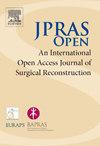压力造就钻石?闭合切口负压伤口疗法对大量减肥患者腹部整形术后并发症的影响--病例对照试验结果
IF 1.5
Q3 SURGERY
引用次数: 0
摘要
背景多项研究显示了闭合切口负压伤口疗法(ciNPWT)的有效性。然而,目前还缺少针对肥胖症术后患者的大规模研究。本研究旨在评估 ciNPWT 对这一高难度患者群体术后伤口并发症的影响。在 2013 年 1 月 1 日至 2023 年 12 月 31 日期间,共确定了 251 例大量减肥后的腹部整形手术。根据切除体重对患者进行配对。我们根据术后伤口处理(传统伤口敷料与 ciNPWT)将 118 名患者分为两组。研究结果显示,血清肿形成率(15 vs 15,P = 1.0)、伤口开裂率(23 vs 20,P = 0.56)、手术部位感染(11 vs 6,p = 0.18)、血肿(17 vs 9,p = 0.07)、完全拔除所有引流管(6.7 vs 6.1 天,p = 0.34)以及 30 天内再次入院(12 vs 11,p = 0.77)或再次手术(12 vs 10,p = 0.63)的总次数相同。因此,我们没有发现证据支持 ciNPWT 可减少体重大量减轻患者腹部整形术后并发症的假设。本文章由计算机程序翻译,如有差异,请以英文原文为准。
Pressure makes diamonds? The impact of closed incision negative pressure wound therapy on complications following abdominoplasty in patients with massive weight loss—results from a case controlled trial
Background
The effectiveness of closed incision negative pressure wound therapy (ciNPWT) has been shown across various studies. However, studies with large patient cohorts comprising post-bariatric patient populations are missing. The objective of this research was to assess the influence of ciNPWT on post-operative wound complications in this demanding patient collective.
Methods
We conducted a retrospective case-control study. Between 1 January 2013 and 31 December 2023, a total of 251 abdominoplasty procedures following massive weight loss were identified. Patients were matched based on resection weights. We matched 118 patients separated into two groups depending on post-surgical wound management (conventional wound dressings vs ciNPWT). The primary outcomes were wound-related disorders and secondary outcomes were the number of readmissions or reoperations within 30 days after the initial surgery.
Results
The study revealed equal incidence of seroma formation (15 vs 15, p = 1.0), rates of wound dehiscence (23 vs 20, p = 0.56), surgical site infection (11 vs 6, p = 0.18), hematoma (17 vs 9, p = 0.07), complete removal of all drainages (6.7 vs 6.1 days, p = 0.34) and total number of readmission (12 vs 11, p = 0.77) or reoperations (12 vs 10, p = 0.63) within 30 days. The second hospital stay caused by revision was significantly shorter in the ciNPWT group (5.8 days vs 12.0 days, p = 0.02).
Conclusion
Consequently, we did not find evidence to support the hypothesis that ciNPWT reduces complications after abdominoplasty in patients with massive weight loss.
求助全文
通过发布文献求助,成功后即可免费获取论文全文。
去求助
来源期刊

JPRAS Open
Medicine-Surgery
CiteScore
1.60
自引率
0.00%
发文量
89
审稿时长
22 weeks
期刊介绍:
JPRAS Open is an international, open access journal dedicated to publishing case reports, short communications, and full-length articles. JPRAS Open will provide the most current source of information and references in plastic, reconstructive & aesthetic surgery. The Journal is based on the continued need to improve surgical care by providing highlights in general reconstructive surgery; cleft lip, palate and craniofacial surgery; head and neck surgery; skin cancer; breast surgery; hand surgery; lower limb trauma; burns; and aesthetic surgery. The Journal will provide authors with fast publication times.
 求助内容:
求助内容: 应助结果提醒方式:
应助结果提醒方式:


